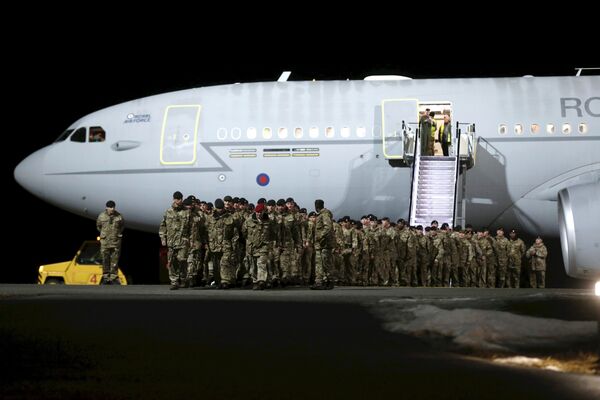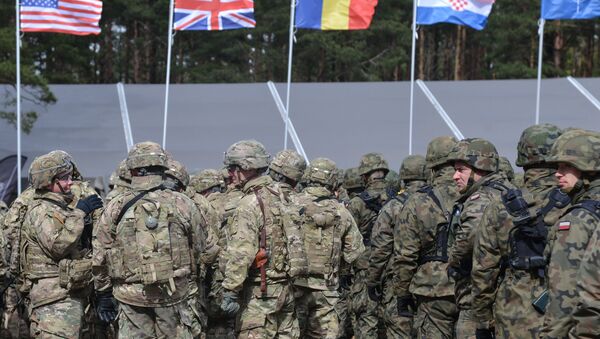The rise marked the second consecutive year of increased defense spending worldwide, and the first consecutive annual increase since 2011, when spending reached a historic high of US$1699 billion.
#SIPRIFacts: World Military Expenditure in 2016
— SIPRI (@SIPRIorg) April 25, 2017
1)#USA $611bn
2)#China $215bn
3)#Russia $69.2bn
4)#Saudi Arabia $63.7bn
5)#India $55.9bn pic.twitter.com/qqDlbHP0BI
Spending oscillated significantly between regions, falling in the Caribbean, Central America, South America and sub-Saharan Africa, but rising significantly in Europe for the second consecutive year.
Military spending in Europe was $334 billion in 2016, one-fifth of the global total, and 2.8% up on 2015. #Milex #SIPRIFacts pic.twitter.com/XzjVIuXFbW
— SIPRI (@SIPRIorg) April 25, 2017
In Western Europe alone, military expenditure rose by 2.6 percent. All but three countries registered increases, with Italy's spending leaping most, by 11 percent. Central and Eastern European countries accounted for the largest relative increases, with budgets growing 2.4 percent.
SIPRI's report notes European defense budgets are expanding due to a perception of a "greater Russian threat," but also highlights how ludicrous this notion is — the country's 2016 defense budget (US$69.2 billion) equals a mere 27 percent of NATO's European members' combined budgets.
#NATO military spending: current 2016 versus 2% of GDP. How would #milex in 2016 change for NATO members if they spent 2% of GDP? pic.twitter.com/rIbCdNHtE2
— SIPRI (@SIPRIorg) April 25, 2017
Such a disconnect between alleged perception and perceivable reality is nothing new in NATO terms.
In March, Bruno Kahl, president of Germany's Federal Intelligence Service, spoke of a growing Russian military threat to NATO on the very same day 130 British soldiers landed at Amari Air Base in Estonia — part of a wider plan to deploy four multinational NATO battalions in the Baltic states and Poland.

The obvious question, and one Russian ministers have often asked, is — who is this enlargement directed at?
The notion of a Russian threat to NATO is even more dubious once the defense spending of non-European members — which likewise rose in 2016 — is factored into bloc's budget. Its total spending rose to US$918.3 billion in 2016, 54.5 percent of the world total. The US naturally accounts for the lion's share of the alliance's spending — and its expenditure was boosted by 1.7 percent in 2016 to US$611 billion.
'US military spending grew for 1st time in 6 years in 2016 – study' — RT: https://t.co/BswQ9nWdIi #Milex pic.twitter.com/g9IvWePGeV
— SIPRI (@SIPRIorg) April 25, 2017
Of course, this figure has since been catapulted yet higher by incoming President Donald Trump, to US$639 billion. While spending still remains 20 percent under its implausible 2010 peak, SIPRI troublingly speculates these increases signal a conclusive reversal of declining US defense spending since the financial crisis.
While Czech Republic, Hungary and Poland turn 18 as @NATO members today, only Poland spends agreed 2% GDP on defense pic.twitter.com/lWsEP4qeNl
— Maciej Kuziemski (@kuziemsky) March 12, 2017
Moreover, Trump has repeatedly demanded NATO members loosen their defense purse strings yet more in future, with the president stating in his first Congressional address that the alliance would only survive if its 28 members all paid their way.
"We expect our partners to take a direct and meaningful role in both strategic and military operations, and pay their fair share of the cost, and meet their financial obligations," he said.
Should all members pay the mandated two percent sum, the disparity between the alliance's total budget and Russia's would be even more asymmetrical, and be further testament to the ludicrousness of the claim it is Russia that poses a military threat.
How would military spending change in #NATO countries if they were spending 2% of GDP? #Milex pic.twitter.com/BHdafcUkHU
— SIPRI (@SIPRIorg) April 25, 2017
However, such efforts by the Trump administration may come to naught. Several prominent European political figures have made clear they have no desire to meet the target — most notably German Foreign Affairs Minister Sigmar Gabriel, who has said he views NATO's two percent of GDP defense spending target as a guideline, not a binding requirement. Germany currently spends around 1.2 percent of its GDP on defense, or around US$37 billion (€35 billion) — by definition, to reach two percent would necessitate almost doubling that figure, a prospect Gabriel dubbed "totally unrealistic."
"I don't know any German politician who would claim that is reachable or desirable. We respect the two percent [figure], but it was formulated as a guideline, not a goalpost," he said.


